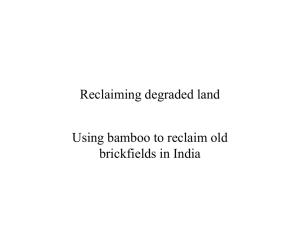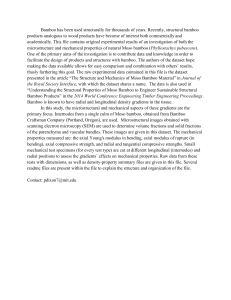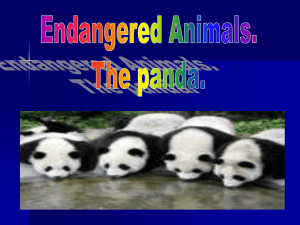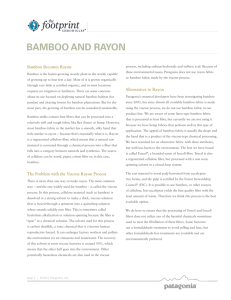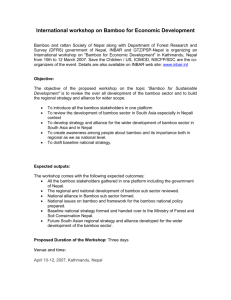WildlifeEcol/B&R (2003) CH 7 - Food and Cover
advertisement
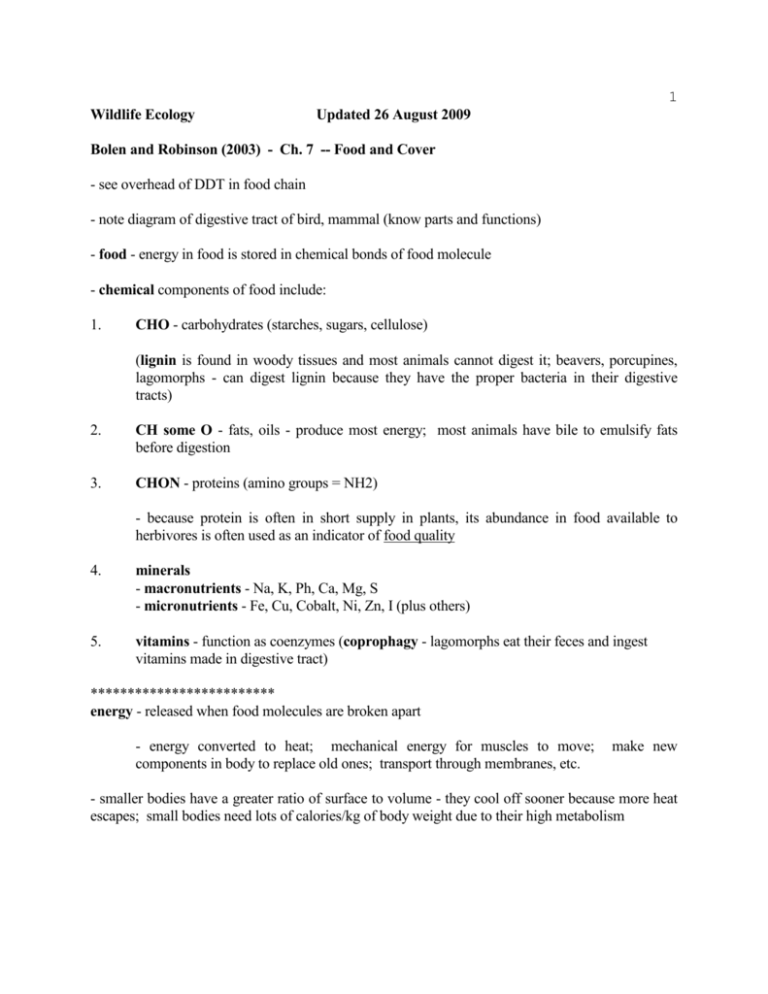
1 Wildlife Ecology Updated 26 August 2009 Bolen and Robinson (2003) - Ch. 7 -- Food and Cover - see overhead of DDT in food chain - note diagram of digestive tract of bird, mammal (know parts and functions) - food - energy in food is stored in chemical bonds of food molecule - chemical components of food include: 1. CHO - carbohydrates (starches, sugars, cellulose) (lignin is found in woody tissues and most animals cannot digest it; beavers, porcupines, lagomorphs - can digest lignin because they have the proper bacteria in their digestive tracts) 2. CH some O - fats, oils - produce most energy; most animals have bile to emulsify fats before digestion 3. CHON - proteins (amino groups = NH2) - because protein is often in short supply in plants, its abundance in food available to herbivores is often used as an indicator of food quality 4. minerals - macronutrients - Na, K, Ph, Ca, Mg, S - micronutrients - Fe, Cu, Cobalt, Ni, Zn, I (plus others) 5. vitamins - function as coenzymes (coprophagy - lagomorphs eat their feces and ingest vitamins made in digestive tract) ************************* energy - released when food molecules are broken apart - energy converted to heat; mechanical energy for muscles to move; components in body to replace old ones; transport through membranes, etc. make new - smaller bodies have a greater ratio of surface to volume - they cool off sooner because more heat escapes; small bodies need lots of calories/kg of body weight due to their high metabolism 2 - formula of Brody (1945) for active mammals is used to estimate caloric needs of wild animals: 3/4 Daily energy requirement = 140 X (body weight in kg ) (in Kcal) - Brody's equation is ballpark figure; exact number of calories varies with insulation of coat, temperature of environment, cover, shelter, etc. ****************************************************************** Ecology and Evolution of Feeding Behavior and Defense - natural selection favors efficient feeders and efficient escapers - survival of species depends on its members obtaining enough food to live and reproduce and replace themselves - plants - have developed characteristics to resist herbivores (e.g., briars, thorns, bitter taste, tannins, alkaloids) - herbivores - have developed ways to cope with defense mechanisms - predators - (usually) have things like keen eyes, speed, stalking ability - prey - have developed watchfulness, agility, camouflage, ability to hide - coevolution - selective pressures are applied mutually between eater and the eaten; coevolution is the joint evolution of 2 or more groups of organisms that have close ecological relationships but do not exchange genes and in which reciprocal selective pressures operate, making evolution of each group partially dependent upon evolution of the other (Pianka 1983) e.g. of coevolution - pine squirrels and conifer trees in NW North America: - trees reduce effectiveness of squirrels and enhance their own survival by: 1. 2. 3. 4. 5. 6. cones hard to open few seeds per cone thick seed coat producing less nutritious seeds dropping seeds early in season before young squirrels feed on them periodically producing almost no cones in a year - squirrels have developed behavioral means to survive -- they choose cones carefully to avoid wasting energy on cones with few seeds; they stockpile cones for lean years (middens) ****************************************************************** Quality of Food - herbivores - their food quality changes with season and the part of the plant eaten (fruits, seeds, actively-growing vegetation are usually better because they have more nutrients) 3 - carnivores - quality of flesh does not vary as much as quality of vegetation - shrews, toads - have bad taste - not eaten very often - in carnivore diets, deficiencies are usually based on quantity rather than quality (herbivores - vice versa) - there is usually a positive correlation between soil with lots of nutrients, good quality forage, and the number of offspring of animals eating it - the trouble is, most good soils are already under agriculture; therefore, only marginal land is left for wildlife - pheasant studies (Anderson and Stewart 1969) - calcium, magnesium, and potassium levels in soil may limit pheasant numbers by their scarcity; other trace metals (e.g., chromium) may limit numbers by their toxic effects at high concentrations - animals sometimes have "specific hungers" for things they lack in their diet (book sites rats choosing correct foods) - read about other examples ****************************************************************** Quantity of Food - woody plants usually send out new twigs in spring and early summer only - digestible nutrients found almost entirely in this new annual growth - if animals eat all of this growth, they may impair the ability of the plant to regenerate twigs - trees/shrubs then die or don't regenerate causing animals to die of mass starvation or they are not healthy enough to reproduce to replace themselves - read about examples Responses to Food Shortages - - some animals live through periods of food shortage by going into a state of hypothermic torpor (e.g., hummingbirds in Peru and European swifts) for a few hours to several days most birds have limited means of surviving long-term food shortages (book mentions that poorwills in the western US hibernate for up to 88 days) hibernation is more common in mammals o body temperatures drop o metabolism slows down Kaibob deer herd mentioned (p.102)(read about it in Chapter 2) 4 another example of large-scale starvation is that of brant, a bird that winters on the Atlantic Coast and eats mainly eelgrass; eelgrass nearly disappeared from the Atlantic coastline from 1931-32 probably due to a parasitic disease - giant pandas in China – eat mainly bamboo which is now scarce (farming has decreased the bamboo available and the pandas need to eat huge quantities of bamboo per day because they evolved as carnivores and only digest about 17% of the bamboo; the flowering cycle of the bamboo is such that there might be periods of bamboo shortage – in former times there were other species of bamboo around that the pandas could eat, but today many species of bamboo are gone from the habitats that are left standing Physical Conditioning and Nutrition – - in modern humans, we usually consider too much fat a bad thing (too easy to put on, too hard to take off) - in the animal world, it is usually the animals that are the healthiest that have the most fat stored - read about study of mallards that looked at a condition index (in this case, they used bird weight divided by wing length; this method allows you to account for the fact that some mallards might be small or large to begin with without relation to their body fat) - in the mallard study, they found that mallards with less body fat (i.e., in poorer condition) were more often shot by hunters; data suggest that maybe the mallards in poorer condition might be driven from suitable feeding areas by stronger birds, thereby forcing the less-hardy birds into places where they might be more likely to encounter hunters Food Management - food requirements are often studied by looking at digestive tracts, fecal droppings - sometimes just of list of eaten foods is put together, but this is less helpful than measuring the ratio of foods taken/food available in habitat - need to look at seasonal change in food requirements; e.g., birds often eat more insects (invertebrates) during breeding season than the rest of the year - artificial feeding - has drawbacks - sometimes allows populations to get too high for what the habitat can support; if feeding is then withdrawn, mass dying can occur, plus habitat might be destroyed (this can change food species availability) 5 - also, different foods (e.g., grains, forage) need different flora in the digestive tract of ruminants (deer, sheep, goats, cattle, antelope) for digestion to occur - animals lose their fear of humans and grow dependent - it often helps to use the condition of the vegetation as a barometer of number of animals (browse availability and consumption) and physical condition of population - if too many animals are present, here are options: 1. do nothing (causes starvation, habitat damage) 2. reduce population (by hunting, introducing predators) 3. live trapping, removal, relocation (costly, and usually offers only a temporary solution) 4. artificial feeding 5. habitat modification (increase natural foods, plant food patches, change succession if necessary) ******************************************************************* Cover - cover offers protection against elements (e.g., temperature, wind) and from predators (give place to hide from predators) Cover as Shelter - fish, reptiles, amphibians especially need cover from elements because they have no internal heatproducing mechanisms - Verme (1965) did studies -- when white-tailed deer were given a choice between winter cover and available food, they chose cover - birds, mammals - often use each other as cover - flock, herd; huddling, roosting together - incubating male emperor penguins with eggs huddle for warmth Cover as Concealment - density or cover boards are often used to measure how much cover there is (I used several for my Ph.D. work - it is simply a board marked off in squares - you count off how many squares are obscured by the standing vegetation) - pheasants - some states ask farmers to leave cover along road sides (often until after nesting) 6 - cover hides the nests; if no cover, some bird species can choose background of nest so that eggs and nest are less conspicuous (e.g., shorebirds, nightjars); female can orientate herself toward the sun to minimize shadows making it harder for predators to see the nest - snow cover - insulation, concealment; voles, deer mice, shrews will use subnivean tunnels (means under snow) ***************************************************************** Edges and Edge Effect - density of wildlife often increases with more edge or amount of intersection (however, it is not always the desirable species; many species are interior species or need large, unbroken tracts of habitat) - edge effect - is the apparent increase in abundance of wildlife at places where 2 habitat types meet - origin of edge might be natural (inherent) or human-made (induced)

